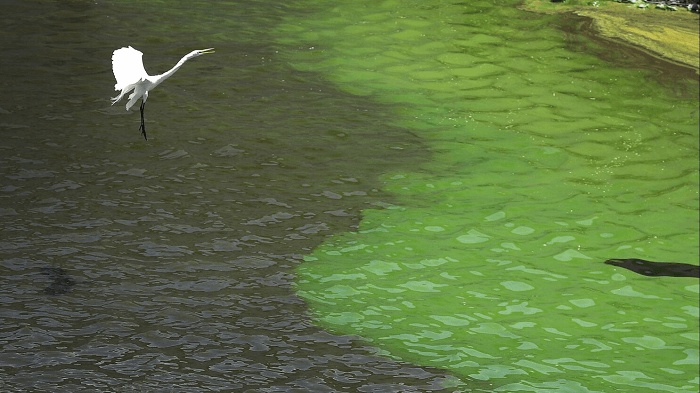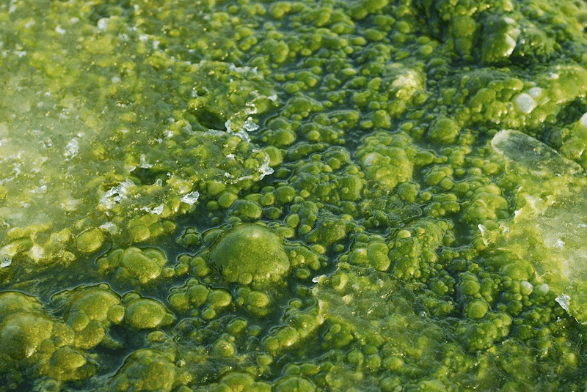Algae DefinitionAlgae are an extremely diversified group of extinct plants from several evolutionary lineages and are primarily photoautotrophic in nature. The various groups of algae are polyphyletic in origin and represent the majority of current plant divisions. Algae are thallophytic, which means that, unlike cormophytes, they do not organize their vegetative body into roots and leafy stems. Many algae lack a circulatory system and exist as lone cells, colonies, filaments, or rudimentary vegetation bodies. In contrast to phanerogams (plants that produce seeds), algae are cryptogams, which reproduce through "concealed" or "hidden" methods. 
The prokaryotic algae (blue-green algae, Cyanobacteria, and Cyanoprokaryota) and the eukaryotic algae (Monera, Protoctista, Fungi, Animalia, and Plantae) are classified in the Monera (Eubacteria) and the Protoctista, respectively, following the classification of living organisms into these five kingdoms. As a result, algae are not part of the Plantae kingdom. Yet, it is generally accepted to refer to algae as "lower plants" in contrast to the vascular "higher plants" because of the mutual trait of photosynthesis. The membrane-bound organelles, mitochondria, plastids, and nuclei are found in eukaryotic algae. These organelles are not present in prokaryotic cyanobacteria; their DNA and photosynthetic thylakoids are free to move about in the cytoplasm. The fact that 'algae' can include both prokaryotic Cyanobacteria and eukaryotic algal groupings shows how artificial and heterogeneous this biological term is. On the other hand, a number of ecophysiological and evolutionary biological grounds support the inclusion of cyanobacteria in the group of algae. Cyanobacteria are able to produce oxygen through photosynthetic processes just like eukaryotic algae, and the notion of endosymbiosis has provided evidence for the evolution of chloroplasts through the incorporation of Cyanobacteria into eukaryotic host cells. It is now known that endosymbiosis has played a significant role in the evolution of numerous algae lineages. Algae display an amazing range of life forms and coping mechanisms in reaction to their surroundings. Chlorophyll is present in most algae. They serve as the major producers on Earth, converting inorganic materials into simple organic chemicals using the energy of the sun. They also generate oxygen, which is necessary for heterotrophic species. Whether it is cold or warm, alkaline or acidic, hyper- or hyposaline, or any other extreme, algae can be found in a variety of habitats, from soil to water. 
Algae have a wide range of cell morphologies since they can be filamentous, unicellular, or colonial (appearing as cell aggregates). Algal cell walls are thin and solid, although their composition varies, and they enclose cytoplasmic membranes. In addition to cellulose, they typically contain pectin, xylans, and alginic acid, among other polysaccharides. Certain walls have calcium carbonate deposits and are calcareous. Certain algae may also contain chitin, a polymer of N-acetylglucosamine. Yet, the euglenoids are distinct from other algae because they lack cell walls. Silica makes up the cell wall of diatoms, creating fossils. Additional cell wall-associated structures include flagella arrayed in various patterns on the cell for locomotion and gelatinous capsules outside the cell wall for adhesion and protection. Moreover, all algae have membrane-bound chloroplasts that contain chlorophyll as well as additional chlorophylls, including b, c, or d. Some have xanthophylls, which are pigments of various colors and can result in different-colored algae. Pyrenoids, which act as locations for starch storage and production, are also found in many algae. Algae utilize a variety of carbohydrate storage mechanisms, including starch, to sustain respiration in the absence of photosynthesis. Lipids, laminarin (1,3-glucan), and paramylon (1,2-glucan) are additional forms of storage molecules. A significant group of primary producers in nature are small photosynthetic organisms called cyanobacteria and eukaryotic algae. On tepui summits, their function as a cornerstone of the ecosystem's productivity is even more crucial than in other biotopes since a considerable portion of the exposed rock surfaces on the tops and walls of tepui are coated with algal or cyanobacterial biofilms rather than macroscopic vegetation. In practically all these habitat types, cyanobacteria comprise most of the biomass, followed by desmids and diatoms. In streams, rhodophytes and green filamentous algae are crucial; coccal green algae, Euglenophyta, Synurophyceae, Cryptophyta, and Dinophyta are rare but do exist in some ecosystems. Algae and cyanobacteria appear to display a large degree of endemism, similar to practically any group of species in Pantepui: There have already been described ten new species of diatoms, four cyanobacteria, one green filamentous alga, and two desmids, but as more research on the microscopic biodiversity of tepuis is done, more are likely to be added. Algae have a variety of significant and advantageous functions in freshwater ecosystems. They serve as the foundation of the aquatic food chain, remove nutrients and contaminants from the water, stabilize sediments, create oxygen, and consume carbon dioxide. Yet, excessive algal growths can harm aquatic systems, imperil the organisms that rely on them or dwell in them, and hinder or impede human usage of the infected waters.
Next Topic#
|
 For Videos Join Our Youtube Channel: Join Now
For Videos Join Our Youtube Channel: Join Now
Feedback
- Send your Feedback to [email protected]
Help Others, Please Share










